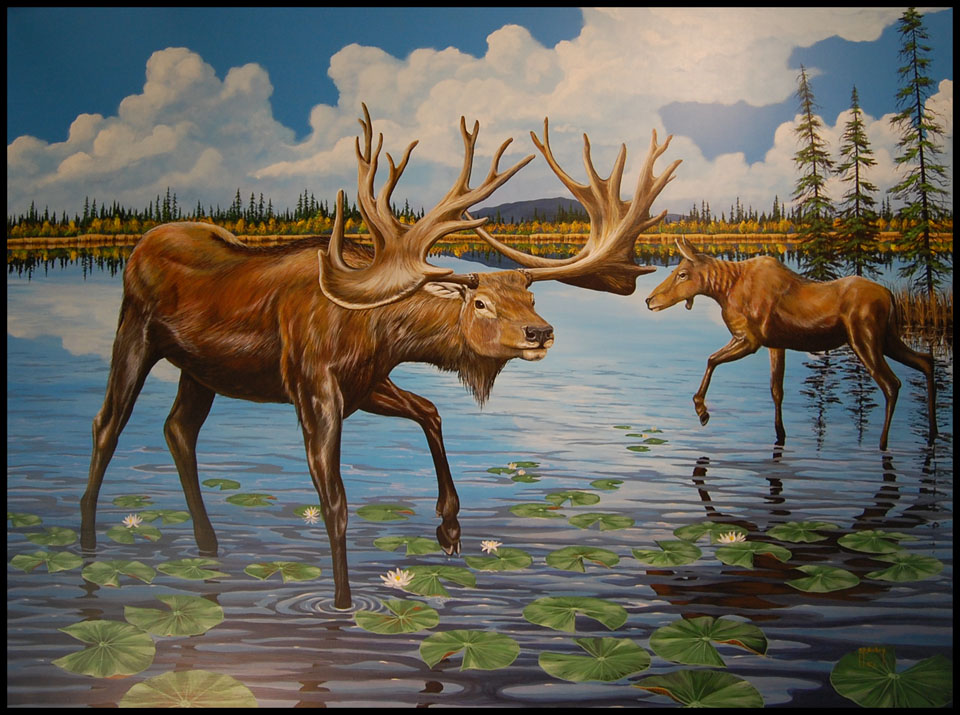Pleistocene Mammals in the Midwest
Related Biomes
Stag-moose
Stag-moose, Cervalces scotti
The stag-moose, also known as elk-moose or Scott's moose (Cervalces scotti), is an extinct moose-like animal from the Late Pleistocene.
Reconstructed skeleton of a stag-moose, Cervalces scotti, on display at the Indiana State Museum in Indianapolis.
Height at shoulder: 1.8 m (6 ft)
Weight: 708.5 kg (1562 lb); Mendoza et al. 2006
Physical Description:

Cervalces scotti from Kendallville, Noble Co., IN.
On display in the Changes exhibit, Illinois State Museum
The stag-moose was a large moose-like animal that looked like a cross between a stag (or elk) and a moose – hence the names "stag-moose" and "elk-moose". This species was slightly larger than the living moose (Alces alces), with a longer, elk-like face, longer legs, and more complex antlers. Indeed, the unique palmation of the antlers, which ended in numerous irregular tines that pointed in all directions, serves as one of the distinguishing characteristics of this genus. The stag-moose also had a different enamel pattern on its teeth, allowing it to be identified in the absence of the distinctive antlers.

Artist's reconstruction of Stag-Moose, by Patrick Gully
Illinois State Museum Collections
The stag-moose is found in deposits that indicate it probably preferred mires and other wetland environments, such as spruce parklands. This habitat is similar to that preferred by living moose, and it is likely that the stag-moose led a very similar lifestyle to that of the modern moose.
The stag-moose appears to have had a relatively limited distribution during the last glaciation. Based on recovery locales, this animal inhabited most of the Midwest, and ranged as far west as Nebraska, Kansas and Oklahoma, and eastward to Virgiania, Pennsylvania and New Jersey.
As with many North American megafauna, the stag-moose went extinct during the Pleistocene-Holocene transition. The stag-moose may have been replaced by the modern moose (Alces alces), which migrated into North America during the Wisconsin period. Recently, AMS radiocarbon dates have been obtained on bone collagen from specimens recovered in Illinois (11,405 +/- 50 14C BP; Schubert et al., 2004) and Wisconsin (10,850 +/-60 14C BP; Long and Yahnke, 2011) that indicate this species likely persisted in the Midwest until at least 10,650 years ago.
Remains of Cervalces scotti have been recovered from numerous paleontological sites in the Midwest, primarily in Iowa, Illinois, Indiana and Ohio. These sites include at least seven in Illinois (Ashmore II, Springfield Sand and Gravel, and Lake Wildwood Haven in central Illinois, and Tonica Thermokarst, Bamford Farm, Beecher, and Biddle Farm in northern Illinois), nine in Indiana (Hazelton, Portersville and Shoals in southern Indiana, Yellowbank Creek in eastern Indiana and Lauer Cervalces, Bender Cervalces, Perkins Cervalces, Potato Creek, and Fish Lake in northern Indiana), and six in Ohio (Carter Site, Mud Run, Wild Cat Swamp, Licking County Cervalces in central Ohio, and Hartville Cervalces and Sheriden Pit in northern Ohio). The first scientifically recorded specimen from the genus was recovered from Big Bone Lick in northern Kentucky, although the type site for the genus is located in New Jersey. Recently, two separate studies recorded the first occurences of stag-moose in Minnesota (Widga et al., 2012) and Wisconsin (Long and Yahnke, 2011).
Kurtén, B. and Anderson, E. 1980. Pleistocene Mammals of North America. Columbia University Press, New York.
Long, C., Yahnke, C. 2011. End of the Pleistocene: elk-moose (Cervalces) and caribou (Rangifer) in Wisconsin. Journal of Mammalogy, 92(5):1127-1135.
Mendoza, M., Janis, C. M., Palmqvist, P. 2006. Estimating the body mass of extinct ungulates: a study on the use of multiple regression. Journal of Zoology 270(1):90-101.
Schubert, B.W., Graham, R., McDonald, H. G., Grimm, E. C., Stafford, Jr, T. 2004. Latest Pleistocene paleoecology of Jefferson’s ground sloth (Megalonyx jeffersonii) and elk-moose (Cervalces scotti) in northern Illinois. Quaternary Research 61:231– 240.
Widga, C., Fulton, T. L., Martin, L. D., & Shapiro, B. 2012. Homotherium serum and Cervalces from the Great Lakes Region, USA: geochronology, morphology and ancient DNA. Boreas, 41(4), 546-556.
Related Animals:



